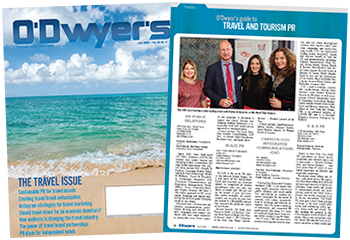 |
| Stacy Moskowitz |
Instagram continues to take social media by storm. In the U.S., there are more than 100 million users — that’s 32 percent of Americans. According to Instagram, 80 percent of accounts follow a business and 68 percent of them interact with brands on a regular basis. That’s nearly 10 times more than with Facebook and the highest of any social media platform.
According to MMGY Global’s 2017–2018 “Portrait of American Travelers” study, 48 percent of Instagram users engage with the app to find new travel destinations and places to explore. It’s no wonder, given the visual nature of the platform, with 95 million photos being posted each day.
 |
| This article is featured in O'Dwyer's Jul. '19 Travel & Int'l PR Magazine. |
But that doesn’t mean brands are using Instagram as the influential tool it can be. While nearly all major travel and tourism brands are on Instagram, marketing strategies must evolve to stay relevant and harness the power the “Gram” can deliver.
You might consider trying various combinations of the following to take your social media marketing to new heights.
User-generated content made simple
Most travelers post vacation photos on social networks. By leveraging user-generated content, you’re showcasing your brand in the most authentic way possible.
Etihad Airways is a great example: it used its one million followers on Instagram as an opportunity to host a contest that asked people to share their favorite travel photos for a chance to win prizes. It’s simple, can be budget-friendly, and honestly, there’s no better way to credibly promote everything a brand has to offer than with earned third-party endorsements.
Do you have to offer an incentive? No. It’s no secret now that sharing beautiful and unique vacation photos on social media to make friends jealous is a thing. Brands can capitalize on this by easily resharing these photos and giving credit to the originators, who’ll likely grant permission.
Designating and encouraging use of related hashtags inserts your brand into the conversation between travelers and their followers. UGC couldn’t be any easier.
Customer service is key
Airlines manage customer service over social networks 24/7, but the original content they and most all travel brands publish aims to educate, entertain and entice. Some of this is because Instagram isn’t necessarily thought of as a hub for customer service. It should be!
With the number of travelers turning to the platform to choose their next vacation, it’s never been more important for social media teams to be helpful and responsive.
Overall, brands must do better to engage customers and provide support via social, not just offer content you think they would like to see. Investing in a social monitoring and engagement management tool, that will up your social customer service game, will show that you’re dedicated and interested in providing travelers with a personalized and unique experience.
This could be the difference when travelers make decisions.
Accurate portrayal of your brand
I’m pretty sure I’d be hard-pressed to find a travel brand that hasn’t at least gotten its feet wet with an influencer campaign of some kind. And since most influencers post alluring and inspirational photos and stories, how could someone not want to visit that destination or stay in that hotel?
Here’s where things can go sideways. After seeing an influencer’s content, travelers have preset expectations on what their experience should be. But according to Expedia, one in five Millennials and Gen X-ers have been disappointed by a destination when comparing it to what they saw on Instagram.
I can’t stress enough the critical importance of brands holding their content partners accountable by allowing them to post only accurate representations of the places they visit. Better yet, copy that accompanies posts should overcommunicate their experience: can anyone do it; is it crowded; are there safety precautions; what do I need to know before I go? Brands that make sure their influencer partners keep their customer’s expectations in mind will come out on top.
Stories, stories, stories
Do you remember how many Instagram users there are? This means Stories has the potential to grow awareness and drive engagement by leaps and bounds. There’s a catch though. In order to be able to view them, a user needs to be connected with a brand to see the content.
This is a prime opportunity for where to put some of your ad dollars. Percent of ad dollars spent on Stories has more than tripled since fall 2017. And with good reason. You can post ads between the slides of other people’s/brand’s stories. Stories ads expand reach because non-followers can see your content, swipe up for more and/or start following your handle.
It’s a no brainer that travel brands should be posting organic content, trialing ads and even beginning to cross over to IGTV to extend content.
The new online booking game
When Facebook introduced the booking feature years ago, it was a bust. Instagram launched a similar feature a few years back, but retailers have still been slow to adopt. This looks to be changing.
With the platform’s larger user base, the percentage of consumers who use social media to make travel decisions, the interesting ways retailers have used the e-commerce feature and the attractive pricing (for now) of early adopters, seems like airline, hotel and car rental brands should be dipping their toes in the water of Instagram booking.
This takes Instagram full-circle, from discovery to action, possibly making business an even more important component of the app. Plus, keeping the entire process all within one app is something we know pleases social media users.
I’d argue Instagram is—or should be—the go-to social network for travel brands. There really is so much that Instagram has to offer. I’ve only scratched the surface of possibilities, but what I know for sure is if you give it a chance and optimize opportunities, you will see meaningful results.
***
Stacy Moskowitz is a Senior Director in Padilla’s Consumer Practice.


 Weber Shandwick is providing PR and marketing communications services to the Moroccan National Tourist Office in New York.
Weber Shandwick is providing PR and marketing communications services to the Moroccan National Tourist Office in New York. Finn Partners has filed its six-month contract with the Bahamas Ministry of Tourism, Investments & Aviation, which is worth $240K.
Finn Partners has filed its six-month contract with the Bahamas Ministry of Tourism, Investments & Aviation, which is worth $240K. Weber Shandwick wrapped up its work for the Ministry of Bahamas at the end of 2023.
Weber Shandwick wrapped up its work for the Ministry of Bahamas at the end of 2023. The Aruba Tourism Authority is boosting its budget 29.4 percent to $2.2M at Zeno Group, according to its 2024 contract, effective Jan. 1.
The Aruba Tourism Authority is boosting its budget 29.4 percent to $2.2M at Zeno Group, according to its 2024 contract, effective Jan. 1. As inflation continues to impact spending, consumers are revisiting their list of what they’re willing to spend more of their money on. Luckily for those in the travel industry, experiences seem to be trending up on the “splurge” list.
As inflation continues to impact spending, consumers are revisiting their list of what they’re willing to spend more of their money on. Luckily for those in the travel industry, experiences seem to be trending up on the “splurge” list. 


 Have a comment? Send it to
Have a comment? Send it to 
No comments have been submitted for this story yet.